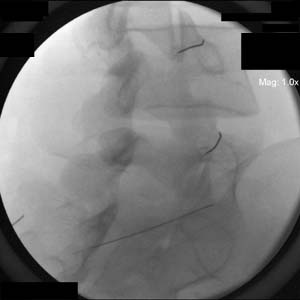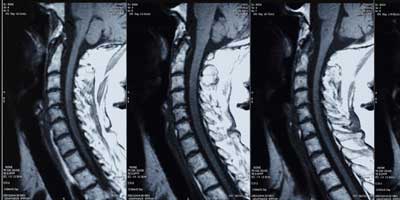Locations

Fax: (303) 762-9292

Understanding Diagnostic Injections: Facet and Medial Blocks
Joint inflammation between spinal bones can cause back pain. Facet and medial blocks involve injecting steroid medication into one or more joint structures to determine if a specific joint generates pain.
- A facet joint block is an injection of local anesthetic and steroid medication into the joint.
- A medial block uses similar medication injected outside the joint space near the nerve that feeds a specific joint.
- Both injection procedures are performed using fluoroscopy.
If pain is relieved, it could mean that the joint or medial nerve generates pain.
 Facet Joint Block
Facet Joint Block

Medial Branch Block
Patient Preparation: At Home
Below is a short list of common instructions. After you are seen at Colorado Comprehensive Spine Institute (CCSI), our doctor will provide a more specific list for you.
- Stop blood-thinning medication 5-days prior to the test
- Do not take any aspirin product 14-days prior to the test
- Stop anti-inflammatory medication 5-days prior to the test
- Stop pain medication 4-hours prior to the test
- Do not eat or drink 4-hours prior to the test
- Arrange for someone to drive you home
Patient Preparation: At the Medical Facility
- The medical staff will review your history, condition, medications, allergies, and other pertinent information.
- You change into a gown and lie down in a hospital bed.
- A nurse monitors your heart function (EKG), blood pressure, blood-oxygen levels (finger oximeter), and other vital signs before, during, and after the procedure.
- Medication is administered to relax you. Light intravenous sedation may be given. Diagnostic spinal injections require you to be awake to respond to questions during the procedure.
What to Expect During the Procedure
- The procedure is performed in a sterile setting similar to an operating room.
- The injection site is cleaned and draped. Skin numbing medication is injected into and around the procedure site.
- Before proceeding, the fluoroscopic C-arm is positioned over you. Fluoroscopic guidance is used during the procedure to guide the needle into the proper position.
- Diagnostic injections may include an anesthetic, steroid, and/or antibiotic.
- The goal of a diagnostic injection is to replicate your typical discomfort (symptoms). Your feedback helps to identify the cause of pain.
After the Procedure
- You are moved to the recovery area where the medical staff continues to monitor your vital signs.
- You may be discharged home in 30 to 60-minutes with written instructions.
- The area around the injection site will feel numb. Relief from typical symptoms may last for 6-hours following the injection.
- Steroids may cause side effects that include blurred vision, frequent urination, increased thirst and change in blood sugar levels, especially in diabetic patients. If these side effects become bothersome or worsen, please call our office.
- If fever, chills, increased pain, weakness or loss of bowel/bladder function occurs, seek immediate medical attention.
- Please follow-up with your doctor for test results.
Possible Complications
A facet and medial block, like other medical procedures, may present risks. Complications include risk of infection, low blood pressure, headache, and injury to nerve tissue.
Patient Restrictions
Some patients should not undergo a facet and medial block. Restrictions include:
- Allergy to the contrast medium and/or drugs to be injected
- Anemia
- Significant asthma
- Bleeding problems
- Infection
- Kidney disease
- Pregnant or breast-feeding
- Severe spinal abnormality
Conclusion
Facet and medial blocks are important to help identify the source of pain. Although the procedure may be uncomfortable, our staff is dedicated to making you as comfortable as possible.








